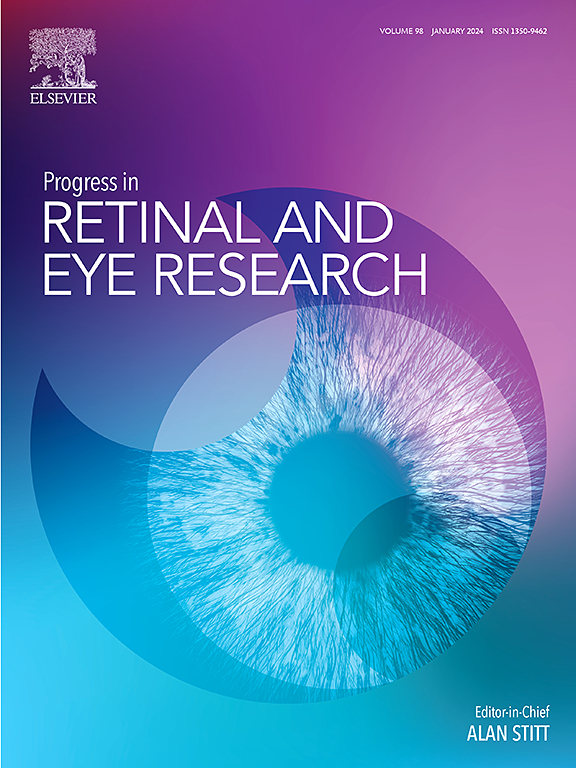Comparative insights into the role of sex hormones in glaucoma among women and men
IF 14.7
1区 医学
Q1 OPHTHALMOLOGY
引用次数: 0
Abstract
Baseline differences in sex hormone levels between males and females influence tissues including the brain and eye. To investigate the effects of estrogens and androgens on ocular physiology and glaucoma, we review the current literature on the influence of primary sex hormones on ocular function, glaucoma incidence and related parameters like intraocular pressure (IOP) at physiologic levels and related to hormone therapies in men and women. These articles reveal activity of estrogen, testosterone, and progesterone within ocular tissues including the retinal pigment epithelium and ciliary epithelium where they likely influence glaucoma pathophysiology through effects on ocular blood flow and aqueous outflow. A growing body of evidence demonstrates a protective role of estrogen in glaucoma. With fluctuations across a woman's lifetime through menstrual phases, pregnancy, and menopause, the general association seen is a lower risk of glaucoma and lower IOP with higher estrogen. Exogenous hormones in the form of oral contraceptive pills and hormone replacement therapy also appear to affect glaucoma risk, although published findings are inconsistent. Few studies have reported a positive association between IOP and serum testosterone, and men treated with androgen deprivation therapy have shown a reduced risk of glaucoma while masculinizing hormone therapies at supra-physiologic testosterone levels have significantly increased IOP. Sex hormone perturbations affect components of glaucoma pathogenesis including IOP and ocular blood flow and overlap with known risk factors like age and sex. Standardized studies are needed to further elucidate the roles of estrogen and testosterone in glaucoma risk and progression.
性激素在男女青光眼中作用的比较研究。
男性和女性之间性激素水平的基线差异会影响包括大脑和眼睛在内的组织。为了探讨雌激素和雄激素对眼生理和青光眼的影响,我们回顾了目前关于原发性性激素对男性和女性眼功能、青光眼发病率和眼内压(IOP)等生理水平及激素治疗相关参数的影响的文献。这些文章揭示了雌激素、睾酮和黄体酮在眼组织中的活性,包括视网膜色素上皮和睫状体上皮,它们可能通过影响眼血流量和水流出来影响青光眼的病理生理。越来越多的证据表明雌激素对青光眼有保护作用。随着女性一生中月经期、怀孕期和更年期的波动,我们看到的一般关联是青光眼的风险较低,雌激素水平较高的IOP较低。口服避孕药和激素替代疗法等形式的外源性激素似乎也会影响青光眼的风险,尽管已发表的研究结果并不一致。很少有研究报道IOP和血清睾酮之间的正相关,并且接受雄激素剥夺治疗的男性显示青光眼的风险降低,而在超生理睾酮水平的男性化激素治疗可显着增加IOP。性激素干扰影响青光眼发病机制的组成部分,包括IOP和眼血流,并与已知的危险因素如年龄和性别重叠。需要标准化的研究来进一步阐明雌激素和睾酮在青光眼风险和进展中的作用。
本文章由计算机程序翻译,如有差异,请以英文原文为准。
求助全文
约1分钟内获得全文
求助全文
来源期刊
CiteScore
34.10
自引率
5.10%
发文量
78
期刊介绍:
Progress in Retinal and Eye Research is a Reviews-only journal. By invitation, leading experts write on basic and clinical aspects of the eye in a style appealing to molecular biologists, neuroscientists and physiologists, as well as to vision researchers and ophthalmologists.
The journal covers all aspects of eye research, including topics pertaining to the retina and pigment epithelial layer, cornea, tears, lacrimal glands, aqueous humour, iris, ciliary body, trabeculum, lens, vitreous humour and diseases such as dry-eye, inflammation, keratoconus, corneal dystrophy, glaucoma and cataract.

 求助内容:
求助内容: 应助结果提醒方式:
应助结果提醒方式:


